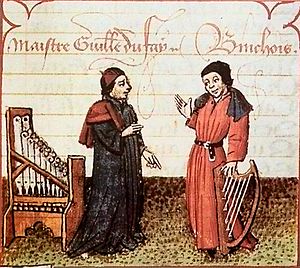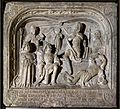Guillaume Dufay facts for kids

Guillaume Dufay (say "GHEE-oam Doo-FYE") was a very important composer and music expert from the early Renaissance. He was born around August 5, 1397, possibly in Beersel, near Brussels. He died in Cambrai on November 27, 1474.
Dufay was one of the most famous composers of his time. He was part of a group called the Burgundian School. His music had a huge impact across Europe in the 15th century.
Contents
Guillaume Dufay's Life
Dufay's will suggests he was born in Beersel, which is now in Belgium. His mother was Marie Du Fayt, and his father was a priest. When he was young, Dufay and his mother moved to Cambrai. They lived with a relative who was a canon (a type of priest) at the cathedral there.
Dufay quickly showed a talent for music. He received his music education at the cathedral and sang in the choir. By age 16, he was given a special job as a chaplain near Cambrai. He even traveled to Konstanz for an important meeting.
Early Career and Travels
From 1418 to 1420, Dufay worked as a subdeacon at Cambrai Cathedral. In 1420, he left Cambrai again. He went to Rimini, Italy, to work for a wealthy family. He returned to Cambrai in 1424 because his relative was ill. After the relative passed away, Dufay went back to Italy. He worked in Bologna for a cardinal. During this time, he became a deacon and then a priest.
In 1428, the cardinal had to leave Bologna. Dufay then moved to Rome to work for the Pope. He joined the Pope's choir. In 1434, he became the maistre de chappelle (music director) in Savoy. He may have left Rome because the papal choir had money problems. However, by 1435, he was back working for the papal chapel, this time in Florence.
Famous Compositions and Return to Cambrai
In 1436, Dufay wrote one of his most famous pieces, a special song called Nuper rosarum flores. This song was performed when the famous dome of the Florence Cathedral was dedicated. The dome was designed by Filippo Brunelleschi.
Around this time, Dufay also started working with the d'Este family in Ferrara. They were very important supporters of music during the Renaissance. He might have met them during his first trip to Italy.
There were some disagreements between the Pope and a church council at the time. Dufay worried he might lose his job, so he went back to Cambrai. To become a canon at Cambrai, he needed a law degree. He earned this degree in 1437.
Later Life and Legacy
Dufay stayed in Cambrai during the 1440s. He also worked for the Duke of Burgundy. In Cambrai, he helped update the cathedral's music collection. This meant writing many new polyphonic (music with multiple independent melodies) pieces for church services. He also helped manage the cathedral's business.
In 1444, his mother died and was buried in the cathedral. In 1445, Dufay moved into a new house. He lived there for the rest of his life. He did spend six more years in Italy, where he wrote many of his compositions. When he returned to Cambrai, he was made a canon of the cathedral. By then, he was the most famous composer in Europe.
He often wrote music for the court of Burgundy. He also met many younger composers who were becoming well-known. These included Busnois and Ockeghem. During this time, Dufay probably wrote a special mass based on the popular song L'homme armé. He also wrote a song using the same tune. This might have been when Philip the Good asked for a new crusade against the Turks. Dufay also wrote a Requiem mass around 1460, but this piece is now lost.
Death and Burial
After being ill for several weeks, Dufay died on November 27, 1474. He had asked for his song Ave regina celorum to be sung as he passed away. He also wanted pleas for mercy to be read between parts of the song. Sadly, there wasn't enough time to arrange this. So, the song was sung at his funeral instead.
Dufay was buried in the chapel of St. Etienne in Cambrai Cathedral. His portrait was carved onto his tombstone. Later, the cathedral was destroyed. The tombstone was lost for many years. But it was found in 1859, being used to cover a well! It is now in the Palais des Beaux Arts museum in Lille.
Dufay's Music and Influence
Dufay's music was played all over Europe. Back then, there was no music printing. So, people who wanted to perform his music had to copy it out by hand.
Dufay wrote many kinds of church music. This included masses (music for church services), motets (sacred choral pieces), Magnificats, hymns, and simple chant settings. He also wrote secular (non-religious) music. His secular pieces included rondeaux, ballades, and virelais. These were all types of chanson (French songs).
His way of composing helped create the style for future Renaissance composers. He used some older techniques, like isorhythms in his motets. This was popular in medieval music. He also used a way of harmonizing chants called fauxbourdon. People loved his music because he was very good at writing beautiful and memorable melodies.
Images for kids
-
Sketch of Old Cambrai Cathedral before its destruction in the French Revolution
See also
 In Spanish: Guillaume Dufay para niños
In Spanish: Guillaume Dufay para niños



